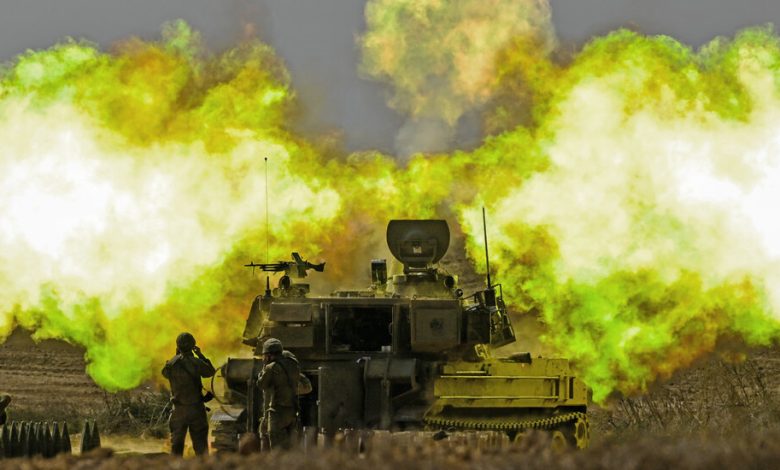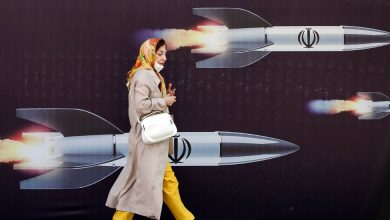Skepticism Grows Over Israel’s Ability to Dismantle Hamas

Standing before a gray backdrop decorated with Hamas logos and emblems of a gunman that commemorate the bloody Oct. 7 attack on Israel, Osama Hamdan, the organization’s representative in Lebanon, professed no concern about his Palestinian faction being dislodged from Gaza.
“We are not worried about the future of the Gaza Strip,” he recently told a crowded news conference in his offices in Beirut’s southern suburbs. “The decision maker is the Palestinian people alone.”
Mr. Hamdan thus dismissed one of Israel’s key objectives since the beginning of its assault on Gaza: to dismantle the Islamist political and military organization that was behind the massacre of about 1,200 people, according to Israeli officials, and which still holds more than 100 hostages.
Prime Minister Benjamin Netanyahu of Israel has repeatedly emphasized that objective even while facing mounting international pressure to scale back military operations. The Biden administration has dispatched senior envoys to Israel to push for a new phase of the war focused on more targeted operations rather than sweeping destruction.
And critics both within Israel and outside have questioned whether resolving to destroy such a deeply entrenched organization was ever realistic. One former Israeli national security adviser called the plan “vague.”
“I think that we have reached a moment when the Israeli authorities will have to define more clearly what their final objective is,” President Emmanuel Macron of France said this month. “The total destruction of Hamas? Does anybody think that’s possible? If it’s that, the war will last 10 years.”
Since it first emerged in 1987, Hamas has survived repeated attempts to eliminate its leadership. The organization’s very structure was designed to absorb such contingencies, according to political and military specialists. In addition, Israel’s devastating tactics in the Gaza war threaten to radicalize a broader segment of the population, inspiring new recruits.
Analysts see the most optimal outcome for Israel probably consisting of degrading Hamas’s military capabilities to prevent the group from repeating such a devastating attack. But even that limited goal is considered a formidable slog.
Hamas is rooted in the ideology that Israeli control over what it regards as Palestinians lands must be opposed by force, a tenet likely to endure, experts said.
“As long as that context is there, you will be dealing with some form of Hamas,” said Tahani Mustafa, senior Palestine analyst at the International Crisis Group think tank. “To assume that you can simply uproot an organization like that is fantasy.”
The Israeli military said this week that it had killed about 8,000 Hamas fighters out of a force estimated at 25,000 to 40,000. But it is unclear how the count is being made. About 500 have surrendered, according to the military, though Hamas has denied that all were from its ranks.
The military has at times delivered positive progress reports on its objectives, describing as “imminent” full control over the areas in northern Gaza where it began its ground offensive in late October.
But Mr. Netanyahu acknowledged on Sunday that the war “is exacting a very heavy cost from us” as the military announced that 15 soldiers had been killed in the previous 48 hours alone. Rockets are still being fired almost daily from southern Gaza into Israel, albeit far fewer than before.
Michael Milshtein, a former senior intelligence officer for Israel, criticized statements by some Israeli leaders depicting Hamas as being at its breaking point, saying that might create false expectations about the length of the war.
“They’ve been saying this for a while, that Hamas is collapsing,” Mr. Milshtein said. “But it’s just not true. Every day, we’re facing tough battles.”
The Israeli military distributed fliers in Gaza recently offering cash for information leading to the arrest of four Hamas leaders.
“Hamas has lost its power. They couldn’t fry an egg,” said the flier in Arabic, quoting a folk expression. “The end of Hamas is near.”
The military promised $400,000 for Yahya Sinwar, Hamas’s leader in Gaza, and $100,000 for Mohammed Deif, head of its military wing, the Qassam Brigades. The two are considered the architects of the Oct. 7 attack.
Although long among the most wanted men in Gaza, the elusive Mr. Deif has avoided assassination or capture. The only picture of him in public is a decades-old headshot.
The bounties appeared to be another indication that Israel is struggling to remove the Hamas leadership.
The group’s top echelon are believed to be sheltering, along with most of its fighters and the remaining hostages, in deep tunnels. Although the Israeli army has said that it demolished at least 1,500 shafts, experts consider the underground infrastructure is largely intact.
The tunnels, built over 15 years, are believed to be so extensive, estimated at hundreds of miles long, that Israelis call them the Gaza Metro.
“Hamas is actually weathering this assault quite well,” said Tareq Baconi, an author who wrote a book about the group. “It’s still showing that it has an offensive military capability.”
Giora Eiland, a retired major general and former head of Israel’s National Security Council, said Hamas had demonstrated the ability to quickly replace commanders who are killed with others equally capable and equally devoted.
“From a professional point of view, I must give credit to their resilience,” he said. “I cannot see any signs of collapse of the military abilities of Hamas nor in their political strength to continue to lead Gaza.”
Hamas is rooted in the Muslim Brotherhood, which was born in Egypt in 1928 as a religious social reform movement but has often been blamed for fomenting jihadist violence in recent decades. Israel once allowed the group to grow as an Islamist counterweight to the more mainstream and secular Palestine Liberation Organization.
In one of Israel’s first, notorious efforts to dismantle Hamas, in 1992, it deported 415 of its leaders and allies, dumping them in a buffer zone along the Israel-Lebanon border. Over the months before their return, they built an alliance with Lebanon’s Hezbollah, the most powerful Iran-backed militia in the region.
The United States and Israel condemn both Hezbollah and Hamas as terrorist organizations.
A string of Israeli assassinations of Hamas political, military and religious leaders also failed to weaken the group. It won control of Gaza in free Palestinian elections in 2006, then evicted its more moderate rival, the Palestinian Authority, in a bloody conflict the next year.
Israel fought three other wars in Gaza targeting Hamas between 2008 and the current crisis.
The operations of the Hamas military wing, the Qassam Brigades, remain opaque. The units were designed to continue functioning even if Israel destroyed parts.
Divided geographically, its five main brigades were in northern Gaza; Gaza City; central Gaza; and two southern cities, Khan Younis and Rafah.
Most of the elite troops were in the two northern brigades, which constitute about 60 percent of the force, said an Israeli military official who requested anonymity under military regulations. About half of them have been killed, wounded, arrested or fled south, the official claimed.
For Israel, the aim is first to dismantle the government, then to disperse the fighters and eliminate the commanders and their primary subordinates, the Israeli official said.
But Azzam Tamimi, a Palestinian journalist and member of the Muslim Brotherhood who has written a book about Hamas, said the group was prepared for that.
“The top leadership can disappear at any time because they can be killed, they can be arrested, they can be deported,” he said. “So they developed this mechanism of the easy transfer of command.”
The Qassam Brigades are divided into battalions, with even smaller units defending individual neighborhoods. Other specialized battalions include an anti-tank unit, a tunnel-construction unit and an air wing whose drones and paragliders were an important element of the surprise attack on Oct. 7, according to analysts and former military and intelligence officials.
The Nukhba Brigade, consisting of about 1,000 highly trained fighters, also appears to have played a central role on Oct. 7.
Trying to eliminate Hamas entirely would require fighting from street to street and house to house, and Israel lacks both the time and personnel, said Elliot Chapman, a Middle East analyst with Janes, a defense analysis firm.
As the United States found in attempting to squash Al Qaeda or the Taliban, the organizations tend to spring back once the armed pressure is lifted. The Gaza fight has been compared to the campaign to wrest Mosul, Iraq, from the Islamic State less than a decade ago, but there are significant differences.
Notably, Hamas is organic to Gaza — it grew out of frustration with the mainstream factions abandoning the armed struggle against the Israeli occupation. Hamas refuses to recognize Israel, and according to its founding charter, is committed to its destruction.
The scale of Israel’s war is likely to radicalize a new generation: More than 20,000 Gazans have been reported killed thus far, according to the Gaza Health Ministry.
Some Gazans curse Hamas, even taking to the airwaves or social media to do it, despite the organization’s history of repressing opponents. Other Gazans, however, say that they still back “the resistance,” and Hamas has long attracted support by providing services like schools and clinics.
A recent poll by the Palestinian Center for Policy and Survey Research found that most respondents endorsed the Hamas attack on Israel. Support for Hamas in Gaza since the war started has risen to 42 percent, from 38 percent, the poll reported.
At best, Israel can probably contain Hamas, experts said.
But even if Israel somehow succeeded in dismantling the group in Gaza, there are still branches in the West Bank and abroad, in places like Lebanon and Turkey, that could revive it.
“The right way to think about it is to degrade the organization to the point that it is no longer a sustainable threat,” said Marc Polymeropoulos, a retired C.I.A. officer who specialized in Middle East counterterrorism.
“You cannot just have a strategy of killing everybody,” he added. “You have to have that day-after scenario.”
Aaron Boxerman, Hwaida Saad and Abu Bakr Bashir contributed reporting.



